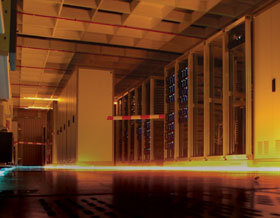

Schneider Electric has introduced StruxureWare Data Centre Operation for Co-location, a data centre infrastructure management (DCIM) application that is specifically designed to address the needs of data centres with multiple tenants. This new offering is able to optimise data centre equipment and space by providing multi-tenant data centre providers and managers – including wholesale, retail, managed hosting and cloud providers – with real-time status updates on data centre capacities, including power, cooling, and available space, to help identify any constraints for future expansion and to better allocate equipment and resources. The application also provides insight into usage and availability on a tenant level, which enables facility managers to operate the data centre as a business through capabilities like detailed chargeback for power and integrated tenant billing and support.
“StruxureWare Data Centre Operation for Co-location provides unique business advantages for multi-tenant data centre operators,” said Soeren Brogaard Jensen, vice president, solution software, Schneider Electric. “This DCIM solution identifies available cage and rack space and has the ability to integrate tenant billing, saving co-location providers time while delivering the most accurate availability information to make business decisions and transactions on the go, at a speed they have never been able to conduct such business before.”
Expanding on Schneider Electric’s existing end-to-end DCIM software suite which enables data centre managers to monitor, operate, analyse and optimise the power, cooling, security and energy usage from building through IT systems, major features of the new system are:
* Space and cage management, which allows the data centre operator to apply grid-based naming for floor mount equipment, utilise cage drawing tools and cage power modelling, and visualise the solution in 3D.
* Integrated tenant billing, which imports tenant and billing account data from the CRM system into the DCIM system for mapping tenant assets, providing detailed power draw, total energy footprint and access to an instant impact analysis at the tenant level – allowing for integrated billing support on sold and used power and footprint.
* Facility maintenance scheduling, providing a complete audit trail on all facility equipment and cages, the ability to create and track maintenance schedules by equipment, and impact analysis to ensure redundancy is maintained during maintenance procedures.
* Measured cage power, which provides detailed charge back to individual tenants through an easy overview of sold and measured power.
* Space capacity reports, which show an instant overview of current space capacities, identifying space as sellable, occupied, reserved or internally used.
* Computer aided design (CAD) Integration, which automatically converts CAD cage drawings into a DCIM model thus keeping all CAD layered information intact for future needs.
The new StruxureWare Data Centre Operation for Co-location facilities integrates with Schneider Electric’s end-to-end DCIM software to enable data centres to monitor, operate, analyse and optimise power, cooling, security and energy.
For more information contact Jacqui Gradwell, Schneider Electric, +27 (0)11 254 6400, [email protected], www.schneider-electric.co.za
| Tel: | +27 11 254 6400 |
| Email: | [email protected] |
| www: | www.se.com/za/en/ |
| Articles: | More information and articles about Schneider Electric South Africa |

© Technews Publishing (Pty) Ltd | All Rights Reserved